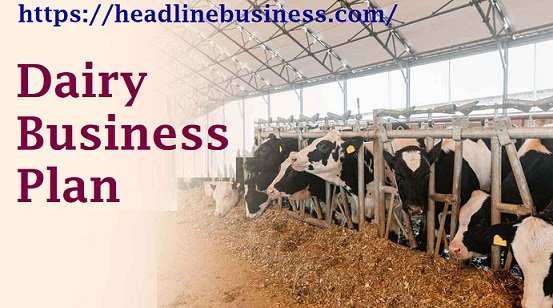Starting a dairy farm can be an incredibly rewarding venture. With the rising demand for dairy products, especially in growing economies, dairy farming presents a lucrative opportunity for entrepreneurs. However, like any business, success in the dairy industry requires careful planning, hard work, and smart decision-making. This blog post will walk you through the essential elements of a dairy business plan, providing you with a detailed roadmap for launching and scaling your dairy farm business.
Whether you are a first-time dairy farmer or looking to expand your existing farm, this guide will help you understand the key components of a dairy business plan, including market analysis, financial projections, operations planning, and risk management strategies. By the end of this post, you’ll have the knowledge and tools to create a well-thought-out business plan that can pave the way for long-term success.
Table of Contents
ToggleTable of Contents:
- Introduction to the Dairy Business
- Understanding the Dairy Farming Industry
- Creating a Dairy Business Plan: Key Components
- 3.1 Executive Summary
- 3.2 Business Description
- 3.3 Market Research and Analysis
- 3.4 Product Line and Services
- 3.5 Operational Plan
- 3.6 Financial Plan and Projections
- Choosing the Right Location and Infrastructure
- Capital Investment and Funding Options
- Dairy Farm Management and Best Practices
- Marketing Strategies for Your Dairy Business
- Risk Management in Dairy Farming
- Expansion Strategies for Your Dairy Business
- Key Takeaways
- Frequently Asked Questions (FAQs)
- Conclusion
- Disclaimer
1. Introduction to the Dairy Business
Dairy farming is one of the oldest and most fundamental agricultural industries, providing essential products such as milk, cheese, yogurt, and butter. In many regions, dairy farming plays a crucial role in the economy, creating jobs and supporting local communities. However, starting a dairy farm can be a complex and capital-intensive endeavor, requiring knowledge of animal husbandry, farming operations, financial management, and marketing.
A well-structured dairy business plan serves as a roadmap that outlines the strategy for achieving business goals, managing risks, and ensuring long-term sustainability. It’s an essential tool for securing funding, attracting investors, and ensuring that you’re on the right track to profitability.
2. Understanding the Dairy Farming Industry
Before diving into your dairy business plan, it’s essential to understand the industry landscape. The global dairy industry is valued at trillions of dollars, and demand for dairy products continues to rise due to population growth and changing consumer preferences.
Key Trends in the Dairy Industry:
- Increased Demand for Plant-Based Alternatives: Consumers are increasingly opting for plant-based dairy substitutes such as almond milk, oat milk, and soy milk. As a result, many dairy farmers are diversifying their product offerings to include these alternatives.
- Technological Advancements: Automation, artificial intelligence, and data analytics are becoming more prevalent in the dairy farming sector, improving efficiency and milk production.
- Sustainability Focus: Dairy farms are under pressure to adopt sustainable farming practices that reduce environmental impact. This includes adopting waste management systems and sustainable feed practices.
- Health Consciousness: There’s a growing consumer interest in organic and natural dairy products, which is encouraging dairy farmers to explore cleaner and healthier production methods.
Understanding these trends is important for developing a competitive dairy farm that meets the demands of today’s market while staying ahead of industry changes.
3. Creating a Dairy Business Plan: Key Components
A comprehensive dairy business plan consists of several essential components. These components help organize your thoughts, analyze the market, forecast finances, and plan operations. Below is a breakdown of each section you should include in your dairy business plan:
3.1 Executive Summary
The executive summary is a brief overview of your business plan. It should succinctly describe your dairy farm, your goals, and your strategy for success. While this section is placed at the beginning of your business plan, it is often written last because it summarizes the entire plan.
Key points to cover in the executive summary:
- Business name and location
- Mission and vision statement
- Business goals and objectives
- Key products and services offered
- Funding requirements (if applicable)
- Summary of financial projections
3.2 Business Description
In this section, you’ll provide detailed information about your dairy farm, including the type of farm you plan to operate. Consider whether you will run a traditional dairy farm, an organic dairy farm, or one that specializes in niche dairy products.
Key points to include in the business description:
- Business structure (sole proprietorship, partnership, LLC)
- Farm operations (size, number of cows, milking processes)
- Type of dairy products you will produce
- Your competitive advantage in the market
- Long-term vision and growth plans
3.3 Market Research and Analysis
Understanding your target market is crucial for the success of your dairy business. In this section, conduct thorough market research to identify potential customers, competitors, and trends.
Key points to cover in market research:
- Target market (local consumers, grocery stores, or larger processors)
- Competitive landscape (who are your main competitors in the area?)
- Market demand (how much demand is there for your products?)
- Pricing strategy (how will you price your products competitively?)
Use tools like surveys, focus groups, and market reports to gather insights into the dairy market and consumer behavior.
3.4 Product Line and Services
The dairy industry offers a variety of products that you can produce, including milk, cheese, yogurt, butter, and ice cream. You might also consider adding value-added products such as organic milk or specialized dairy products like lactose-free milk.
Key product and service options:
- Raw milk
- Processed milk (pasteurized, homogenized)
- Cheese (hard, soft, artisanal)
- Yogurt and kefir
- Butter and cream
- Dairy-based beverages (milkshakes, smoothies)
Consider diversifying your product offerings to appeal to different market segments, including health-conscious consumers or niche markets.
3.5 Operational Plan
Your operational plan outlines how your dairy farm will function on a day-to-day basis. This includes the management of farm operations, staff, equipment, and facilities.
Key points to cover in the operational plan:
- Facility requirements (barns, milking parlors, storage units)
- Equipment needed (milking machines, refrigeration units)
- Animal care practices (feed, health monitoring, breeding)
- Staffing requirements (farm workers, veterinarians, technicians)
- Milking and production processes
3.6 Financial Plan and Projections
The financial plan is arguably the most critical section of your dairy business plan. It provides an overview of the financial health of your business and includes projections for revenue, expenses, and profitability.
Key points to cover in the financial plan:
- Startup costs (land, equipment, cows, construction)
- Operating costs (feed, salaries, utilities)
- Revenue projections (based on expected milk production and product pricing)
- Cash flow projections
- Profit and loss statement
- Break-even analysis (how long it will take to become profitable)
It’s essential to have realistic financial projections based on industry standards and market trends.
4. Choosing the Right Location and Infrastructure
Selecting the right location for your dairy farm is critical to its success. The location should be accessible to key markets, have a stable supply of resources, and meet regulatory requirements.
Key considerations when choosing a location:
- Proximity to dairy product markets
- Availability of grazing land and feed resources
- Climate and weather conditions (impact on milk production)
- Regulatory environment (permits, zoning laws)
- Access to transportation and distribution networks
Additionally, your infrastructure needs will vary depending on the size of your farm. Small-scale operations may require basic equipment, while larger farms need advanced technology and infrastructure for milking, refrigeration, and waste management.
5. Capital Investment and Funding Options
Starting a dairy farm requires significant upfront capital investment. Your financial plan should outline the capital needed for land acquisition, equipment, livestock, and operational expenses.
Funding options:
- Personal savings
- Bank loans
- Grants for agricultural businesses
- Venture capital or angel investors
- Crowdfunding
You may also want to consider government subsidies or low-interest loans designed to support agricultural businesses.
6. Dairy Farm Management and Best Practices
Effective dairy farm management is essential to ensure smooth operations and profitability. Here are some best practices for managing a dairy farm:
- Implementing efficient milking and feeding routines
- Regularly monitoring the health and well-being of cows
- Utilizing technology for tracking milk production and animal health
- Practicing sustainability and minimizing waste
- Building a skilled and reliable workforce
7. Marketing Strategies for Your Dairy Business
Marketing your dairy products effectively is crucial for attracting customers and expanding your brand. Some strategies include:
- Building relationships with local grocery stores, restaurants, and cafes
- Creating an online presence through social media and a website
- Offering free samples or promotions to attract new customers
- Branding your farm as organic or sustainable to appeal to health-conscious consumers
8. Risk Management in Dairy Farming
Dairy farming involves several risks, including fluctuations in milk prices, disease outbreaks, and adverse weather conditions. Developing a risk management plan is essential to mitigate these challenges.
Risk management strategies:
- Crop insurance for feed production
- Veterinary care plans for animal health
- Diversifying product offerings to reduce financial dependency on milk sales
9. Expansion Strategies for Your Dairy Business
Once your dairy business is established, you may consider expansion to increase your revenue. Some expansion strategies include:
- Increasing herd size and milk production capacity
- Diversifying into value-added dairy products
- Expanding into new markets, such as exports or online sales
- Implementing automation and technology to scale operations
10. Key Takeaways
- A dairy business plan is crucial for guiding the growth and development of your farm.
- Market research is vital to understand consumer demand and competition.
- Financial planning helps ensure your dairy farm is profitable and sustainable.
- Operational efficiency, good management practices, and smart marketing are keys to long-term success.
11. Frequently Asked Questions (FAQs)
Q1: What is the startup cost for a dairy farm?
- The startup cost varies widely depending on location, size, and scale. A small-scale dairy farm might cost between $50,000 to $100,000, while a larger farm could require millions.
Q2: How do I secure funding for my dairy business?
- Explore options like loans, grants, angel investors, and crowdfunding. Many governments provide agricultural grants and low-interest loans.
12. Conclusion
Starting a dairy farm is an exciting and profitable venture, but it requires careful planning and significant investment. A well-structured dairy business plan will provide you with the foundation to succeed in the competitive dairy industry. By following the steps outlined in this guide, you can ensure that your dairy business is on the path to success.
Disclaimer: The information provided in this article is intended for informational purposes only. It should not be considered as professional advice. Always consult with industry experts, financial advisors, or agricultural consultants before making any significant business decisions.




